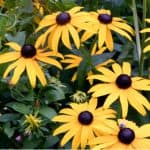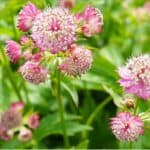Last updated on May 3rd, 2022
Our site is reader supported, this means we may earn a small commission from Amazon and other affiliates when you buy through links on our site.
The Black-Eyed Susan, also known as Rudbeckia or Cornflower, it’s a very popular perennial or annual plant because of its large, bushy collections of colourful flowers that bloom between July and October, with the bright yellow with black central cones being the most popular. They have daisy-like flowers that surround the conical disc for which they have become so popular.
You can find varieties that are annuals, biennials, and even perennials that you can grow outdoors, in containers, and some even indoors as a conservatory or houseplant. With so many different varieties that can survive year after year, it’s understandable why gardeners of all shapes and sizes are looking to incorporate them into their gardens.
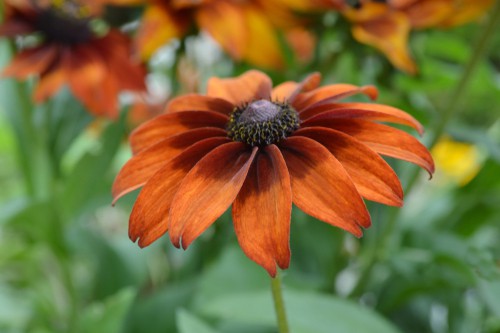
How to grow Rudbeckias
Rudbeckias are easy to grow as long as you give them full sun or dappled shade. They need soil that is enriched with ample organic matter and can retain moisture, particularly in the spring and summer. You want to make sure the plants never become waterlogged and also don’t ever dry out, so you need to make sure you have a place in your garden that has the perfect growing conditions for them. Mix in plenty of organic matter and compost from your compost bin, you could even think about setting up a wormery and mix in plenty of gravel to improve drainage if needed.
The top annual and perennial varieties to consider planting
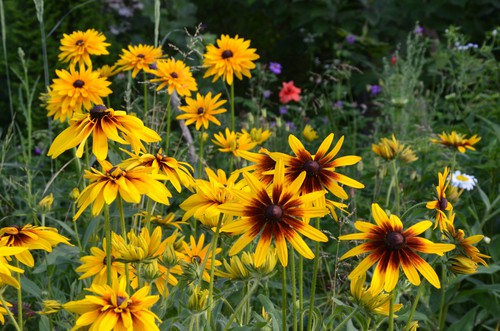
There are many varieties from which to choose. You can pick plants that are annuals and last for one year, these will need planting every year. Annual Rudbeckias produce some stunning dwarf varieties, or alternatively, you can opt for perennial Rudbeckias that die back in winter and grow every year, producing stunning flowers throughout summer.
Annuals
- Rudbeckia hirta ‘Cappuccino Bronze’
- Rudbeckia hirta ‘Cherry Brandy’, known for its cherry-red flowers
- Rudbeckia hirta ‘Prairie Sun Orange’, radiates lemon yellow all the way down to the central, green cone
- Rudbeckia hirta ‘Rustic Dwarf’, a shorter variety that has flowers ranging from rich mahogany to yellow
- Rudbeckia hirta ‘Toto Dwarf’, a compact variety with golden yellow flowers
- This stunning cultivar is the world’s first red Rudbeckia
- Outstanding garden performance and stunning colour
- Produce a mass of attractive, cherry-coloured blooms all summer long
Perennials
- Rudbeckia fulgida ‘Goldstrom’, deep with yellow petals and an orange tint
- Rudbeckia laciniata ‘Herbstsonne Golden’
- LONG-FLOWERING, BOLD COLOUR: Vibrant garden perennials delivering striking golden yellow blooms with deep brown centres from July to October. Ideal for borders, prairie-style gardens, and mixed perennial beds, it provides months of colour while needing minimal care. Flowers look fantastic as cut flowers too, brightening up both your garden and your home.
- POLLINATOR MAGNET: Loved by bees and butterflies, Rudbeckia ‘Goldsturm†brings essential pollinators to your garden. Its nectar-rich blooms provide a vital food source, while its long-lasting flowers keep gardens buzzing with life. A top choice for wildlife-friendly and eco-conscious gardeners.
- HARDY, EASY TO GROW AND LOW MAINTENANCE: This RHS Award of Garden Merit winning variety is known for its resilience and effortless growth. Thriving in full sun, it tolerates drought, clay soil, and urban pollution, making it ideal for low-maintenance planting. Simply deadhead flowers for an extended blooming season and enjoy reliable performance year after year.
- DETAILS: Supplied as a set of 3 established plants in 9cm pots, ready to plant. Grow in full sun in well-drained soil for best results. Water well during establishment, then reduce watering as the plants mature.
- ABOUT US: At YouGarden, we believe that gardening is for everyone. Based in rural Lincolnshire we have our own 11 acre nursery, meaning that we are in close contact with our plants, so that we can guarantee our plants will thrive because we've grown them ourselves. We also source product locally, nationally and internationally to ensure we give our customers the best range, highest quality and greatest value for money. All our products will arrive in nursery fresh condition.
Sowing Rudbeckia plants
If you are going to sow them from seed when growing in your garden, you have different rules for annuals versus perennials, although they are sown in the same way.
Sowing annual seeds
If you are sowing annuals, you want to sow the seeds between February and April using pots. Using old pots will be fine, or seed trays full of seed compost.
Make sure the temperatures remain between 20°C and 25°C, so using a heated propagator can help with this. Transplant the seedlings only when they are big enough to be in pots, 9cm pots would be ideal. You should harden off your plants by growing them in cooler conditions for about two weeks before you plant them outside permanently, which usually should be no earlier than May to protect them from frost.
Sowing perennial seeds
If you are sowing perennials you want to sow them in trays or pots with good seed compost between February, however, these can be sown as late as July and keep the temperatures between 18°C and 20°C. This is also a little cooler than the annual varieties.
Transplant the seedlings only when they are big enough to be in small pots, again 9cm pots would be perfect for pricking the seedling into. You should harden off your plants by growing them in cooler conditions for about two weeks before you plant them outside to avoid damaging them with cold weather. Only plant out when the risk of frost has passed.
Planting Rudbeckia
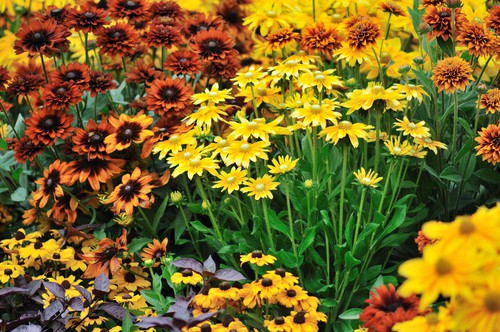
When you are ready to plant younger plants that you have grown yourself or plants you purchased from a nursery or garden centre, the perennial varieties can be planted at any time, although it is best to wait until autumn or spring.
When you are ready, you want to dig over the planting area and add a lot of compost, especially if you have heavy clay soil. Dig a hole that is large enough to accommodate the root ball.
Place the root ball into the hole and adjust the depth of the plant so that the crown of the leaves is level with the soil, be careful not to plant them too deep. Backfill the area and add some granular slow-release plant food or bone meal. Water it well and add a layer of 5cm of mulch thick around the soil to help with water retention because they can dry out easily.
The same methods are required for planting annual varieties; you just want to make sure that you do it in the spring when the chance of frost has passed because they only last one season so you don’t want them to be killed off straight away from the frost.
How to care for Rudbeckias
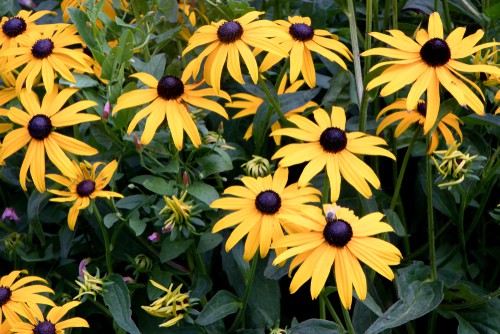
Care for annual Rudbeckias
Your care will come down to what variety you have. If you are caring for an annual, you want to water the plants as much as necessary to keep the soil moist throughout the year. You should always water the soil directly, not the foliage. During the growing season, you can encourage more flowers by applying some liquid plant food every few weeks. You can also encourage additional blooms by deadheading any faded flowers.
Care for perennial Rudbeckias
If you are growing perennials you should apply granular plant food in the spring and then add a layer of compost or mulch around the base of the plant to help control weeds during the spring.
Much the same as the annuals, you should water them as much as is necessary to keep the soil moist and you should water at the soil level, not over the top of the foliage because doing so can burn the foliage. Add some liquid plant food every other week during the growing season to encourage more flowers. Perennials are more compact and they rarely need help other than deadheading the faded flowers to encourage more flowers.
Dividing Rudbeckia perennials
With the perennials, you should divide overcrowded plants every three or four years in the spring.
Last update on 2025-04-03 / Affiliate links / Images from Amazon Product Advertising API



